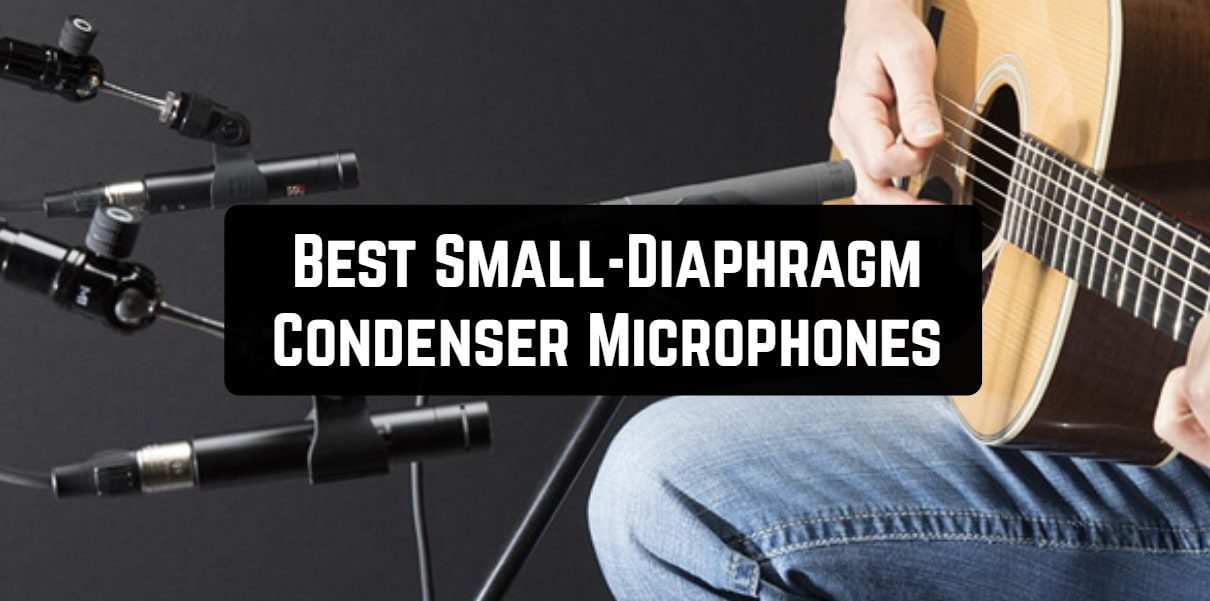Condenser microphones have lower noise levels but have improved midrange and bass performance.
The natural sound of condenser microphones is indispensable when you need the highest sound quality. That’s why they’re used in concert halls, theatres, and recording studios.
In this review, we present the best condenser microphones. They have good characteristics and are suitable for all purposes.
C1000S
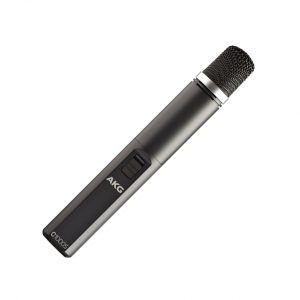
Characteristic features of this model include the ability to use sound equipment with phantom power or AA batteries.
This microphone also has an adapter with three frequency response settings. It is useful for different sound sources.
A built-in polar converter allows you to change the directional pattern. You can also switch from cardio to hyper-cardioids.
The condenser microphone provides high-quality sound in the frequency range 50-20000 Hertz.
It has a sensitivity of 6 mV/Pa and a nominal resistance of 200 ohms. The recommended load impedance is 2 kOhm. In the complete set with a microphone a softcover, wind protection, a microphone holder is delivered. The model is issued in black color.
The device supports phantom power 9-52 V DC.
It has an internal attenuator to adjust 0/-10 dB for the best performance with instruments. They generate powerful sound pressure. There is no distortion.
Stage screen, gusts of wind and other stage distortion can be easily cut off with the 80 Hz bass filter. Excellent autonomy and versatility with support for 2 1.5V AA batteries.
The LED indicator informs you of the current status of the microphone.
The microphone is equipped with a protective cover for safe travel on tour and long-term storage of the valuable device. The set also includes wind protection. It has a bracket for stable installation on the microphone stand and a directional diagram converter.
Check also 15 Best Condenser Microphones
PRO37
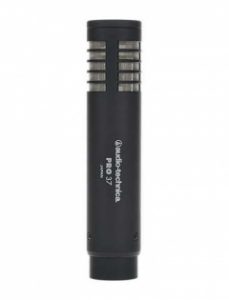
The condenser microphone has a small aperture, cardioid directivity diagram. Its frequency response is 30-15000 Hertz.
This model is notable for its ruggedness and reliability. This microphone can work with high overloads on sound pressure with minor distortion.
The microphone has a sensitivity of 7.9 mV / Pa, its nominal resistance – 200 ohms. To work the microphone PRO37 requires phantom power 11-52 V, current consumption – 2 mA.
It is a capacitor microphone equipped with a thin miniature diaphragm. It provides a natural-sounding instrument.
This microphone is perfect for “live” performance and recording choral singing. It copes perfectly with higher sound pressure levels.
The cardioid directivity diagram cuts off unnecessary noise at the back and side of the unit. Windproof foam screen that absorbs gusts of wind is designed for outdoor use.
It is versatile in use thanks to supporting the 11-52 VDC phantom power supply function.
This microphone has a corrosion-resistant, professional XLRM acoustic connector. It is attached to the 5/8″ microphone stands with a holder.
The basic package includes a soft carrying case, wind protection, removable holder. It also has an adapter for compatibility with the 3/8” euro standard mount.
C451B
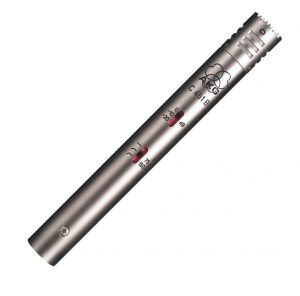
The high-strength metal housing reliably protects the C451B from mechanical damage. Sound equipment can experience significant sound pressure overloads.
At the same time, it provides clear detailed sound without coloration or distortion.
C451B is equipped with a cut-off filter at frequencies below 75-150 Hz. Microphone sensitivity is 9 mV / Pa, electrical resistance – 200 ohms.
The phantom power supply required for operation is from 9 to 52 volts, current consumption is about 2 mA.
The metal case of the microphone covers the whole surface. There is a shield against tiptoeing and radio interference. The capsule is fixed inside on an elastic suspension.
It neutralizes the perception of mechanical noise during movement or vibration. There are two -10 and -20 dB switches on the housing to prevent a level collapse.
The microphone transmits a dense, harmonica-rich sound. It also conveys all the nuances in the sound of acoustic guitar, violins, cello, percussion.
The package includes SA60 holding, W90 wind protection and a compact transport case.
KM 184
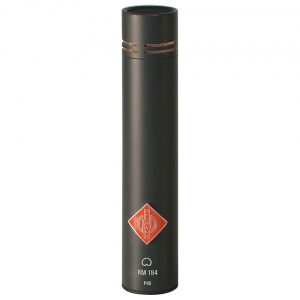
The condenser studio KM 184 has a small aperture and a cardioid directivity diagram.
The Neumann KM 184 ensures the highest level of articulation when recording acoustic instruments.
The entire 180th Neumann lineup is a mini-microphone with a small aperture.
The KM 184 is available in two housing colors, nickel (NI) and matte black (MT).
The KM 184 has a very wide range of applications. You can use it to shoot drum overheads, to record high hit, working drum, acoustic guitars.
The microphone can perfectly convey all the harmonics of steel strings. You won’t have to worry about overloads. Due to its small aperture size, the KM 184 can withstand the highest levels of the largest noise pressure.
The frequency resolution of this high-end microphone is between 20 hertz and 20 kilohertz. Of the entire 180 range, the KM 184 is the most sensitive.
The Neumann KM 184 is also low impedance (50 ohms). This makes it easy to use with any length of wire without fear of loss of quality.
But, the manufacturer’s recommended load impedance is 1000 ohms.
KSM141
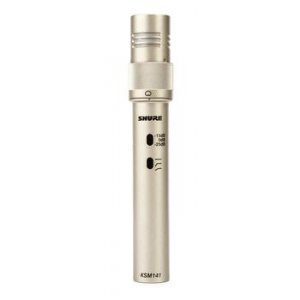
Cardioid or pie chart. Directionality is changed by a special swivel mechanism with a collar on the microphone body.
The design is robust enough for use not only in the recording studio but also in concert activities.
Reliable and accurate microphone KSM141 is able to withstand loads of significant sound pressure. At the same time, it has a low level of its own noise.
The transformerless Class A preamplifier module delivers clear and transparent sound. Its housing is equipped with miniature switches.
They allow you to control the dynamics and amplitude-frequency response in the bass spectrum. Modes for dynamic range: 0 dB, -15 dB, -25 dB. Modes for microphone AFC: 115 Hz cut-off point -6 dB/octave, 80 Hz cut-off point -18 dB/octave.
The microphone connector is a standard XLR connector. It is gold plated to ensure a secure connection. An ultra-slim 24-carat gold plated aperture provides high sensitivity.
It has a wide frequency range for stringed musical instruments. There will be no noise in your recording.
The KSM141/SL comes with an A100WS foam wind protection, and A57F rotary holder and a transport case.
SM81
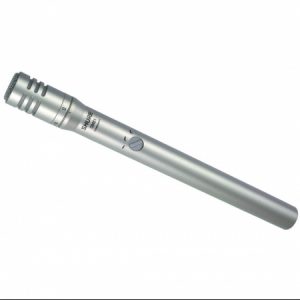
It is used to remove the full range of sound vibrations. It is suitable for strings, drums, wind and other acoustic instruments in recording studios and on stage.
It is also popular for vocal performance and when working together with guitar and combo amplifiers.
The main advantages of the microphone:
- Ultra-compact dimensions
- No interference and no noise
- Sample frequency response
- Pure and clear sound
This microphone has a built-in attenuator to adjust the 0/-10 dB level for the best performance with instruments. It generates powerful sound pressure. There is no distortion.
External noise is suppressed by a built-in 3-point low-pass filter.
The microphone serves for discreet installation near drums, percussion, piano, various string. It is also suitable for wind musical instruments.
It is equipped with a switch. It is truly a versatile microphone for multi-purpose applications. It is convenient for concert performance. This microphone has no transient distortion.
It’s ideal for recording any instrumental part. The windproof screen is included as a basic package for better noise protection in outdoor environments.
Professional studio sound quality is maintained even at high SPL levels. Super-reliable and versatile microphone stand mount via 5/8″ threaded swivel adapter.
A zippered protective pouch for transport and storage is included.
SM137
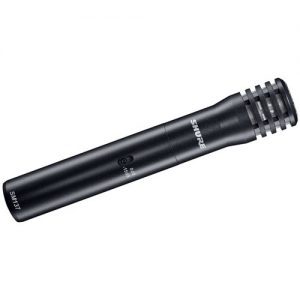
It has a cardioid directionality and a significant dynamic range of 122 dB. The own noise of the microphone does not exceed 19 dB-A.
This corresponds to the level of top professional instrument microphones.
The aperture of the microphone is made of flexible gold-plated foil with a Mailer base. This prevents the capsule from sticking out even at significant sound pressure levels.
The capsule is fixed to the antivibration suspension. It is also protected by a three-layer metal mesh. It additionally protects the membrane from airflow and mechanical damage.
SHURE SM137 model has a possibility to switch attenuator to -15 dB mode at very loud sound sources.
The microphone is useful in professional recording studios for recording live musical instruments. For example, strings, guitar, piano, grand piano, brass band, wood band, double bass. It can also be used to sound instruments or groups of instruments on stage.
The SHURE SM137-LC kit also includes an A25D rotary holder, A3WS wind protection and a Shure 95C2313 protective cover with clasp.
KM183-D
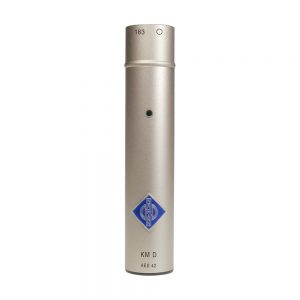
It also has integrated analog to digital converter. Due to its wide dynamic range, this microphone can be used for a variety of purposes.
For example, for vocal or speech reproduction, sounding musical instruments.
The KM183-D digital output stage allows you to playback or record sound at 24-bit resolution. It has a sampling rate of up to 192 kilohertz.
With the optional DMI-2 interface, you can connect to the digital input of your mixing console, mobile recording device or computer.
Microphone KM183-D provides high-quality sound in the frequency range of 20-20000 Hertz. It has a sensitivity of 12 mV / Pa, rated resistance – 50 ohms.
It is able to work with SPL sound pressure up to 150 dB. Phantom power supply required for operation is 48 Volts, current consumption is not more than 3.5 mA. The microphone comes with a swivel mount adapter, wind protection, and a wooden case.
This microphone is designed to remove sound from a nearby source. It can be used as a main microphone as well as for capturing room acoustics. It is ideal for use in a muffled room, without any parasitic reflections.
It can take part in the “AB” sound recording technique. Suitable for recording strings, wind and percussion instruments. You can use it for recording acoustic guitar, grand piano, organ, male and female choir.
Rode NT5
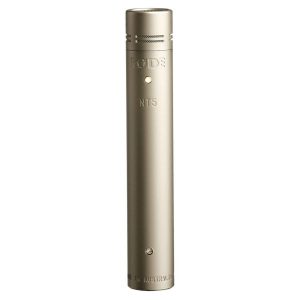
It is designed for work on stage, in recording studios. Also, this microphone is used for recording vocals.
You can use it for speech reproduction, sounding acoustic keyboards and strings.
NT5 provides detailed sound in the frequency range of 20-20000 Hz. It has a cardioid directional chart and a sensitivity of 12 mV/Pa.
It is designed to operate with the largest sound pressure of 140 dB.
The adapted frequency range of 30-15 kHz is suitable for excellent work with acoustic guitars, pianos, overheads.
The NT5 has a rugged all-metal case. Use a rigid steel grille to protect the microphone capsule from shocks. A 48 V phantom power supply is required to activate the microphone. This electroacoustic unit can also be recorded from a 9-volt Crown type battery.
In addition to the microphone, this model is supplied with a swivel adapter-holder. It has wind protection, a leather cover bag and instructions for use.
The manufacturer promises a 10-year warranty. But to do this you need to register on the company’s website and make an application.
SKM184
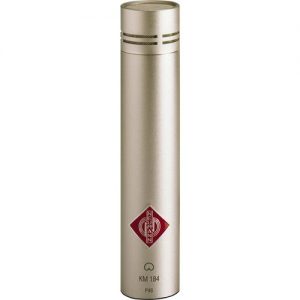
It is designed for the close sounding of musical instruments. Also, this microphone is perfect for sounding wind/string, drums, piano, organ, and chorus.
SKM184 has a cardioid directional chart, digital output that meets the standard AES/EBU 42. With the optional DMI-2 interface, all microphone parameters can be remotely controlled.
You can also connect it to the digital inputs of mixers, computer interfaces, and portable recorders.
The SKM184 provides detailed and transparent sound in an audio frequency band from 20 to 20,000 Hertz.
It can operate with sound pressure up to 133 dB. This microphone has a low intrinsic noise level (13 dB) and a sensitivity of -39 dB.
In addition to the main device includes wind protection WNS100, rotary adapter SG21-bk, and a wooden case.
The microphone consists of two parts – the head with a capsule KK 184 and the KM D module. It contains the electronic stuffing that allows amplifying and digitizing the signal.
It turns out that the signal received from the capsule is immediately digitized. Thus, the chance of getting a tip or losing the signal level is minimal. This digital approach also extends the dynamic range of the microphone. It reduces the noise level.
Microphone SKM 184 is suitable for universal use. For example, in situations where you want to avoid capturing the extraneous sound that is outside the microphone’s axis.
It can successfully take part in “XY” and “ORTF” recording techniques. Can handle the role of the broadcast microphone in radio broadcasts. For musical instruments can be used as a dot microphone and as an overhead.
Suitable for the close recording of strings and wind, piano and guitar amplifiers, percussion.
Check also 7 Best vocal microphones under $200

